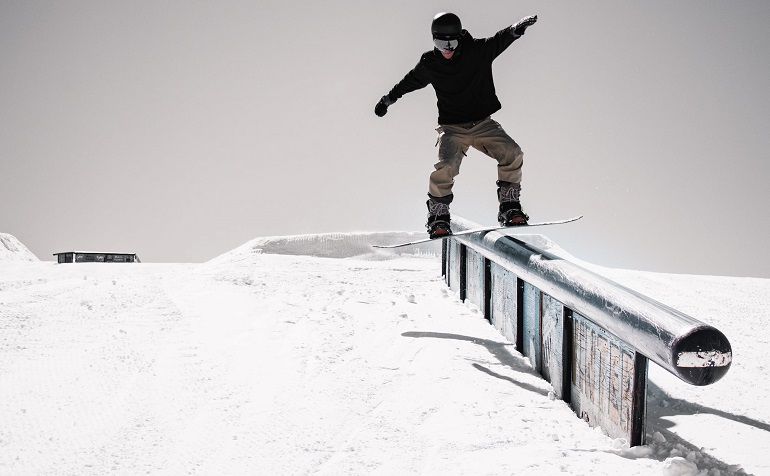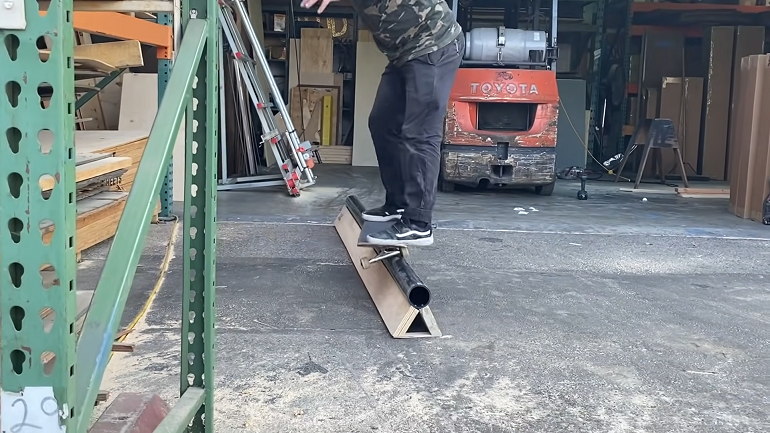Starting out in the sport of snowboarding, what one might imagine as the be-all-end-all “type” of snowboarding might be the freestyle kind. You know, the one that takes place over the open mountainous regions with loops and jumps and fun actions being shown off.
So many terms in the sport of snowboarding are relatively unknown. It’s a vast ground out there, so we don’t blame anyone, amateur or otherwise, for not knowing about the art of Snowboard Jibbing.
The most interesting thing to note is that, among the various kinds of activities included under the snowboarding umbrella, Jibbing is one that is practiced in a terrain park.
Read on to learn more about jib-style snowboarding, and all the basic tips to get started!
What Is Jibbing in Snowboarding?
Quick Answer
To jib on a snowboard essentially means the act of riding, sliding, grinding, or jumping against a surface that has an edge.
This includes rails, hit rails, and even obstacles like boxes or barrels! You need precision, dexterity and good balance to accomplish jibbing tricks.
Explained

Practiced commonly in a terrain park, jibbing is the act of maneuvering your snowboards in a way that you can slide, ride or edge along a flat or rounded surface, such as a box, rail, or even trees.
However, boxes and rails are the main obstacles. Start with wider boxes, and once you feel comfortable, you can move on to thinner rails. The core idea is that you always need to work on your jump.
Jumping with dexterity and having a board flat and well-sized enough to practice your form is the name of the game.
Looking for a good board and using it is half the work. A great snowboard perfect for jibbing tricks is different from regular snowboards. Not only is it smaller in length, but it is also flatter. To perform a trick well, one must buy the best quality boards.
Also sometimes called street snowboarding due to being constantly practiced in urbanized environments, jibbing a snowboard requires lots of energy, agility, and adaptability.
You need to be fit and in healthy condition to practice. The skills required are not only difficult to master, but since they take time, you basically have to rely on repetition to learn. Hang in there, learners!
Some common jibbing tricks include the F5 Lipslide, FS 50-50, and the BS Tailslide.
Where Does the Concept of Jibbing Come From?
While the foundations of snowboarding were laid out by many accomplished people over the course of the late 90s, it was a few snowboarders in particular who helped popularize the jib.
One of these accomplished snowboarders was Tom Sims, a pioneer of snowboarding from California. He practiced the jib so much that he became widely popular and talked about.

Soon many people wanted to try out the activity for themselves. Sims also helped in the creation of freestyle boards made for performing a jib on the freestyle snowboard.
Something novel and exciting Sims did was to get skateboarders to try out their skills on snowboards. Skateboarding skills seem quite different from snowboarding ones, but the riders found they could jib using the same techniques they used on their own skateboards.
Sims even had his photographer take photos of the new tricks being performed to be sent to the International Snowboard Magazine. This increased their marketing momentum, and the activity became very mainstream.
Kids and young adults alike equally wanted a part in learning the processes of performing a jib!
Is Jibbing Snowboard Common?
Performing this activity on a snowboard is not as common as you might think. When people typically learn snowboarding, they learn the basics first, how to glide on the snow and ride freely.
But jibbing is for when you want to expand your horizons, and test your agility and physical prowess. Skill is required to maintain weight in the snow, and time is needed to feel comfortable.

A box or a rail can be difficult tools to get used to. Their edges can make it easy to slip and fall, and sliding and grinding along takes grit – literally.
But for when you want to challenge yourself, learning to jib can be exciting. It tests your limits and creativity. Normal, everyday things like a box or a rail or even a hit rail can become new and fun. It’s about the meaning you give to it.
But if that’s not your cup of tea, then that’s fine too. Riding and snowboarding freely is enough. Remember to have fun.
Guide on How to Perform a Jib on the Snowboard
In order to perform a snowboarding trick like a jib successfully, there is lots of learning to be done from the ground up.
When you’re snowboarding freely, lots of things are based on your instinct. This means that they come to you naturally. While jibbing though, you will have to train yourself to learn the techniques.
The biggest thing is to buy the best snowboard specifically made to perform a jib. Then, you must remember to always keep the base of that board flat. This requires balance, and investing in snowboard instructors can help in honing your form.
One more tip we can think of to help is to stray from the edges of the board. When you use the edge too much to make movements, it may cause more harm than good.
Start with a box in a terrain park. Go slow on the snow, approach the box straight up, then try to slide over it while maintaining your weight in the center.
This is the most basic trick. Since a box has a wide surface area, you will find it easier to ride over it. After you have mastered the humble box, you can graduate to the rail.
Rails might scare you as they are quite narrow but never fear. It only takes one strong jump and the same technique as riding on the box.
It will take trial and error. Performing a trick is never easy, but it can be after practicing and mastering it. After you do the simple riding on the box, etc., you can try doing it sideways. This means that once you ride midway, turn to an angle and continue to ride across.
Some tips are to keep your toes stable. Don’t lean back toward the tail of your board, and stay flexible enough to keep yourself upright, even while going at an angle.
Take care of your speed too, as a very fast approach can make accidents more likely.
Advanced Jibbing
Once you have understood the basic approach and turn combination applied to various obstacles, you can take it away to any other object available in the park.

This applies to cut trees, staircase hit rails and broken equipment. This is because most items will remind you of your humble beginnings – the box or the rail.
Performing other jibs on creative interesting obstacles will allow your activity to go from amateur to advanced.
How Does Snowboard Jibbing Differ from Skateboard Jibbing?
A simple trick to answer this is to understand skateboard jibbing principles as grinding. While skateboarding, grinding tricks are quite easy to do, and the best part is that the same skills are transferable to the snowboard.

So in that sense, there is not much difference between the skateboarder and the snowboarder, as they use the same skillset.
However, in the park environment, the act of jumping on the obstacle is different. Your feet are untied to the skateboard, but snowboards are made with the feet guards attached, to secure your foot down to the base.
This means that less energy and slightly different technique is needed for riders to catch the jump onto the obstacle. But skateboarders will need to ollie to perform the same jib.
Finally, practicing the trick is easier on snowboards, as less injuries happen due to falling on snow that cushions you rather than hard marble or pavement.
Final Thoughts
Let’s go over the basics again. To perform a jib successfully, you need to make the environment, the terrain park site work for you.
Use the tools at your disposal, your skill in snowboarding freestyle and try it out in a new setting for yourself! If anything, you will have gained more understanding of snowboard jibbing in general and improved in both areas.
Jibbing can be quite enjoyable. Bring your friends, perform a trick or two, and just have a good time!
0 Comments